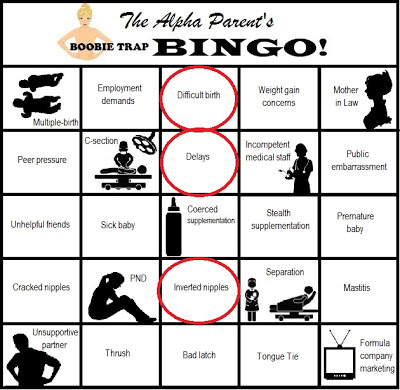 About 10 per cent of women have inverted nipples. Mothers often cite inverted nipples as a reason to abandon breastfeeding. However the reality is that such mothers could still breastfeed; Babies feed on areolas, not nipples. Inverted nipples can however, make latching more problematic. The areola of women with inverted nipples tends to be very firm. If this breast tissue doesn’t flex when baby attempts to latch, the baby can find it difficult to get a large enough mouthful to latch properly. How can mothers overcome this dilemma? After enduring much heartache, Brianna, a mother of two, finally found the solution.
About 10 per cent of women have inverted nipples. Mothers often cite inverted nipples as a reason to abandon breastfeeding. However the reality is that such mothers could still breastfeed; Babies feed on areolas, not nipples. Inverted nipples can however, make latching more problematic. The areola of women with inverted nipples tends to be very firm. If this breast tissue doesn’t flex when baby attempts to latch, the baby can find it difficult to get a large enough mouthful to latch properly. How can mothers overcome this dilemma? After enduring much heartache, Brianna, a mother of two, finally found the solution.

“Breastfeeding the first time around was a one of the toughest things I had ever experienced. My son was born early and experienced some complications. He was not breathing well and his blood oxygen saturation level (meaning how well oxygen was being absorbed into his blood) was low. Due to these complications I was not able to nurse him right after delivery and had to wait several hours until the doctor and nurses were able to get his levels up.
Once I was able to nurse I found out that, because of the way my nipples were inverted, my son would have difficulty latching on. It was important that I get some nutrients into him some way, so the nurse gave me a medical-grade breast pump. I syringed the breast milk from the bottle into my son’s mouth each feeding for the first few days after his birth. Then the process began of working on latching and sucking.
I started going to lactation meetings with the hospital’s lactation nurse. Every three to four hours I pumped my milk, syringe-fed my baby, and then cleaned the necessary parts of the pump. At this point I was at my wits end. I felt helpless, I felt defeated, and mostly I felt like a failure. I would put my son down in his crib and go to my room and cry. It was a constant struggle every feeding, but I knew I couldn’t give up. It is so important for a baby to get at least 6 months of breastfeeding to build up their immune system. It is a huge bonding experience for a mother to be able to provide for her infant. Also, I had chosen to stay at home after my son was born so money was tight; I really needed to save the money that would have otherwise been spent on formula.
It wasn’t until between month 3 and 4 when I finally felt like my baby and I were a team working together to meet his needs. I was finally able to get him to latch! I did this using a nipple shield. I felt such a rewarding feeling knowing that we were finally able to enjoy the times of feeding. There were some other struggles along the way, but none as hard as those first few months.

I applaud any woman who chooses to breastfeed and sticks with it. We are faced with many walls to hurdle over and much temptation to give in to formula. Whether it be the distracted baby who is more interested in what’s going on around them then nursing (this usually happens between 4 and 5 months) or the difficulty of scheduling outings between feeding time, because there isn’t much support in the public for nursing mothers. To those of you new mothers who are thinking about nursing and aren’t sure – go for it! You will never regret trying. There are ways to make it work whether it be support and advice from other nursing mothers/ family members, the support group La Lecha, reading material (I like “New Mother’s Guide to Breastfeeding” put out by the American Academy of Pediatrics) or a combination of all three.
This second time around I went into breastfeeding my daughter feeling like a PRO! With all of my gained experience and the wisdom of what to expect we have breezed through many of the obstacles that can trip up a breastfeeding mother. Good Luck breastfeeding moms and keep up the good work!”











